Crawling Back: Amazing Spider-Man #14 Review (The Osborn Prelude, Part 1)
The Green Goblin's first appearance successfully introduces an enigmatic adversary who promises a new era of Spidey storytelling
—by Nathan on May 19, 2023—
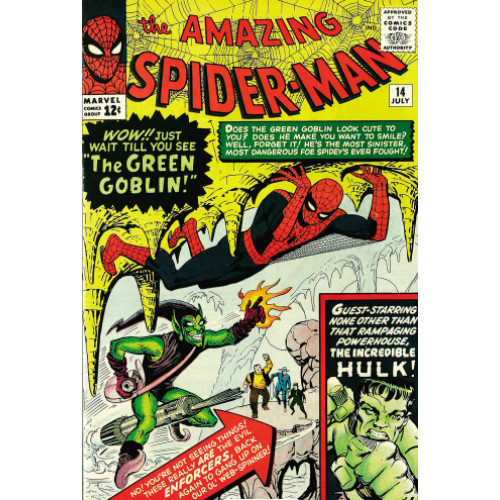
Over the last three years at this blog, a cavalcade of cacophonous criminality has attempted, futilely, to bury our favorite Web-Head (largely figuratively, but on occasion, very literally!). We’ve seen plots performed by symbiote-suited brain-snackers, multi-limbed scientists, rotund crimelords, even former police officers and six-supervillain syndicates. Despite the enormity and diversity of Peter Parker’s rogues gallery, there’s a specific Halloween-themed villain we’ve shied away from. Any guesses as to who? A few hints: he rides a glider, throws pumpkin bombs, and during his first several appearances, initially obscured his true identity.
“Well, Nate,” you say, “that narrows it down to at least two.”
Okay, here’s another: he’s not orange.
The period I’ve covered so far–the mid-to-late 80s followed by the early 90s–were not highly focused on Spidey’s self-proclaimed arch-enemy, the Green Goblin. To be more specific: Norman Obsorn’s Green Goblin. Supposedly dead since 1973, the Green Goblin had left a legacy carried on by others. Norman’s son Harry performed in the role for a while. Briefly, Harry’s therapist took over the moniker and weaponry. Most prominently, an orange knockoff calling himself the Hobgoblin blazed through the skies, creating a complicated mystery I’ve touched on previously.
None hold a jack-o-lantern’s candle to the OG Gobbie.
We are nearing Spidey’s famed 200th Spectacular Spider-Man issue, which deals with a dramatic turning point in the Spider/Goblin conflict. Between this post and the one covering that issue (somewhere in the distant, unknown future), I intend on scouring 11 narratives centered on the Green Goblin, dissecting the villain’s history leading up to the events of SSM #200. As these issues all take place prior to late 1991, my current position in Spidey history, “Crawling Back” is the suitable path to take through this madcap adventure. Similar to my “Infinity Prelude” posts building towards Jim Starlin’s Infinity Gauntlet series, I will periodically post a “chapter” covering a distinct period in the infamous, increasingly complicated Spider/Goblin saga. I originally figured I would do this issue-by-issue, breaking down each Green Goblin appearance, but I quickly decided that lumping these together by story (whether a single issue or multiple) would be more engaging to analyze.
So welcome to the ride. Clamber aboard your goblin gliders and strap yourselves in. Our first stop is the 1960s, as Spidey co-creators Stan Lee and Steve Ditko unleash their latest creation on unsuspecting readers, unknowingly changing the landscape of Spidey comics to a degree few other stories produced at the time could fathom.
“The Grotesque Adventure of the Green Goblin”
Writer: Stan Lee
Penciler: Steve Ditko
Inker: Steve Ditko
Colorist: Stan Goldberg
Letterer: Art Simek
Issue: Amazing Spider-Man #14
Issue Publication Date: July 1964
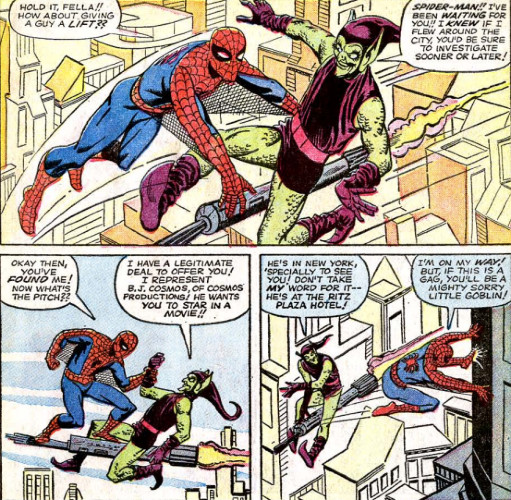
Before Jon Watts…before Marc Webb…before Sam Raimi even…there was B.J. Cosmos.
Yes, Lee and Ditko’s incredibly obscure side character, the Oscar-winning film producer of The Nameless Thing From the Black Lagoon in the Murky Swamp! and head of Cosmos Productions, is the man responsible for helming the first-ever Spider-Man movie. I mean, okay, the movie never finished filming, but this guy had the concept decades before Raimi, or even James Cameron, were ever attached to any big-budget Spidey film. That’s still a first, right?
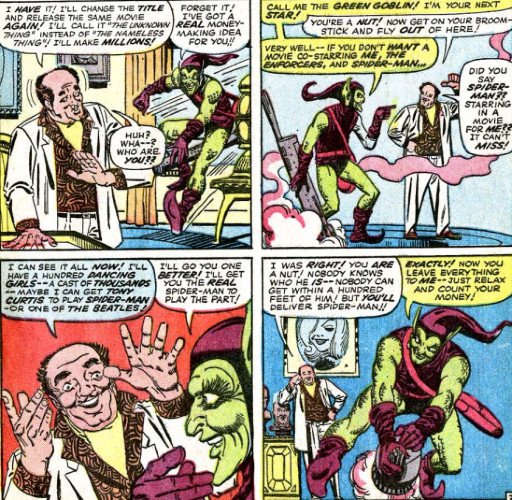
Course, it’s all the Goblin’s idea, a clever way of roping Spider-Man into a trap.
I don’t know at what stage Lee and Ditko were at with the Green Goblin when they created this issue. The character’s main thrust–his secret identity–is set up from the start. He’s mysterious, a real person whose true name we won’t know until later. Where other villains were given names (Doc Ock was always Otto Octavius; the Big Man was revealed to be Frederick Foswell the same issue he debuted) and some were offered origins or backstories (such as Electro), the Green Goblin’s real name and face are left intentionally hidden. Even villains such as the Vulture and Mysterio, whose names weren’t revealed until later, didn’t have their characterization hinge upon a long-running mystery. It didn’t matter that the Vulture was Adrian Toomes, and though knowing Mysterio is special effects wizard Quentin Beck helps readers understand where his gimmicks originate, discovering his day-to-day occupation didn’t drive readers’ interest when he first appeared.
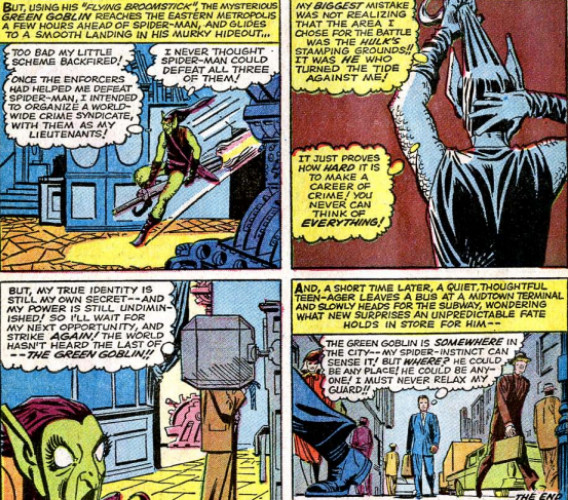
But the Goblin? His appeal is the mystery, and though readers would not discover for a few years just who was behind the mask, his intrinsic connection to Spider-Man’s cast elevates the suspense. Yes, at this time, his identity hadn’t yet been fleshed out–Lee and Ditko would famously argue over their respective ideas for who should wear the Goblin mask–but in retrospect, knowing Norman Osborn steers the Goblin’s broomstick and leers at Spider-Man from behind his grinning, gargoyle guise gives the villain’s first appearance added impact. We’re not just witnessing the introduction of another flavor-of-the-month supervillain; history is wrought here, even unintentionally. It doesn’t matter that Lee and Ditko didn’t have Norman pegged for this role–Harry hasn’t even shown up in Peter’s social circle yet–but this issue bears the weight of decades of conflicts, twists, and deaths.
The narrative itself proves to be simple. I couldn’t explain to you why, of all the fiendish plots he could concoct, the Goblin turns to a movie producer to create a fake film to draw in Spider-Man. Recruiting the Enforcers (former employees of the aforementioned Big Man, who Spidey had trounced a few issues earlier), the Goblin leads them into the desert, “staging” a practice fight with Spidey for the film. It’s then Spidey realizes he’s in the soup. The fight is real. Fancy Dan, Ox, and Montana aren’t just actors with lifelike makeup; they’re the actual Enforcers! And this whacko flying around on a metal witch’s broom is throwing some heavier ordinance around.
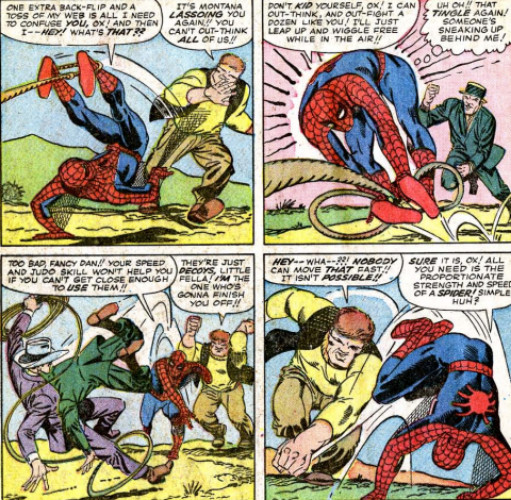
The plot’s fine, if not a little corny. I find myself more easily able to forgive some of Lee’s lackluster Spidey plots, probably because I feel highly nostalgic about the stories–these are some of the first issues I read when I was introduced to the Silver Age back in 2004, and I’m certain younger me had not crafted the more analytical, critical perspective I possess nearly two decades later. I can look past some of the simpler or goofier aspects and embrace the sheer fun of the concept in a way I don’t allow myself to do as easily when reading repeated X-Men/Brotherhood of Evil Mutants skirmishes or slogging through Lee’s general verbosity.
Perhaps the hardest bit to overlook comes in the form of a brief subplot: as Peter plans to travel to California to shoot Daily Bugle photos for JJJ (his cover for Spidey’s activities), he ruffles Betty’s feathers. The young woman believes Peter will fall in love with a Hollywood starlet and forget all about her. I’ve never minded the romantic tension between Peter and Betty–at the very least, it never feels stagnant, like Scott Summers and Jean Grey’s early relationship or the confounding Matt Murdock/Karen Page/Foggy Nelson triangle–but this feels ridiculous, Betty’s self-worth given over to such irrational hypothesis. Hurray for Lee to remember Peter’s engaging supporting cast, but this just feels like “The Man” needed Betty to say something and chose the first idea which popped into his brain…which doesn’t feel far from his general creative process. And we don't get much from other cast members either–May characteristically fusses over Peter's health, and JJJ "harrumph"s his way through a few scenes, chomping on a cigar.
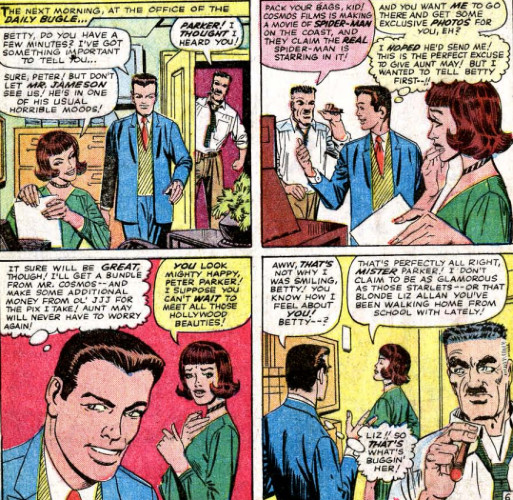
Lee and Ditko’s most engaging sequence takes place in a cave, where Spidey begins picking off the Enforcers one-by-one. Ditko’s art (colored by an unknown individual) brings out an eerie vibe as Spidey strikes from the darkness, hoisting Montana and Fancy Dan into the air like the predatory arachnid he’s named after. Lee’s dialogue adequately conveys tension (save for Montana’s goofy accent–I’ve never seen anyone combine “we all” before), but it’s Ditko’s pencils which set the scene–a shadowy Spidey yanking Montana through sheer force before snagging Dan with waist-wrapped webbing. The gloom of the cave, the silhouetted figures, the absence of Spidey or cave roof as Dan is hefted into the seeming unknown…it’s a wonderfully plotted scene, narrative told primarily through art.
The scene allows the issue a moment to breathe, a lull in the action and a setting a bit more unique than "wide open desert." Alan Moore, in his seminal Watchmen series, delivers a quote late in the story, uttered by a prisoner to his fellow inmates: "None of you seem to understand. I’m not locked in here with you. You’re locked in here with me." Other writers have espoused similar sentiments–such as Mark Millar in his World War II-era Wolverine story "Prisoner Number Zero"–and Montana gives his twist on it here. The line, combined with Ditko's artistry, represents Spidey getting the upper hand on these guys, throwing a wrench into the Goblin's meticulous machinations. He's tricked the trickers, trapped the trappers.
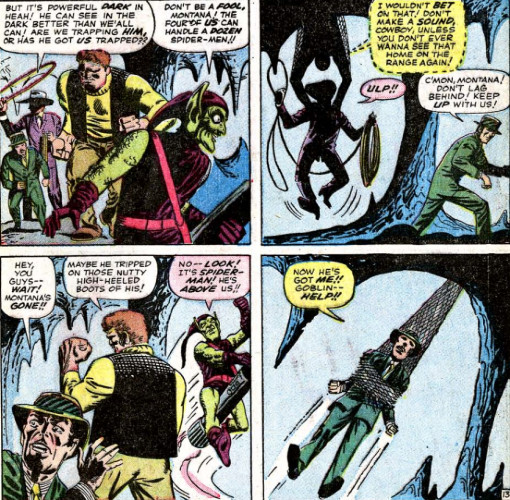
And then we meet the issue’s second green guy.
The Hulk doesn’t have to appear in this issue. The Hulk doesn’t even need to appear in this issue. This lumbering lummox, this monosyllabic man-child could easily have brooded in the back of his cave, removed from the action. But never doubt Stan Lee’s ability to bring in a guest star to heighten the mag’s appeal. Why just have Spidey and a few punch-able punks when the Green Goliath can show up? Occasionally, cameos such as these can feel haphazard, thrown in lazily to offer a full breadth of the world. I mean, New York has a lot of heroes, but how often can Thor zoom by at the same time Spidey’s hanging out on the side of a building? This is one of those areas where you must suspend your disbelief just a tad and ignore the convenience.
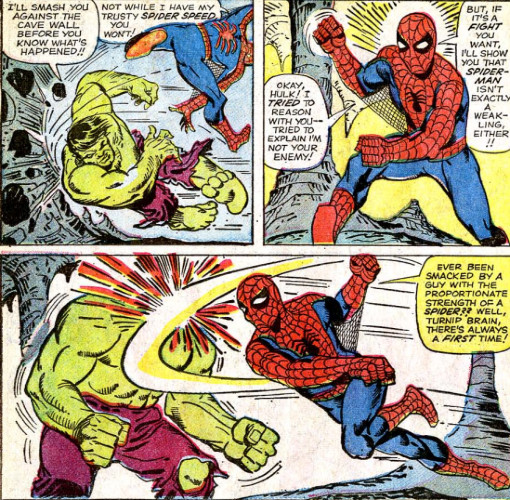
Fortunately, if we ignore the whole “our main characters just stumble into the one cave where the Hulk was hiding” convenience, the plot device does make some sense. The Hulk’s a loner, hides out in caves. His dramatic appearance, emerging from the smoke of the Goblin’s bombs, further heightens the tension. Admittedly, he draws some attention away from the Goblin, who all but vanishes for a solid three pages (a shame we never receive a "Goblin vs. Goliath" battle of the green guys). Still, kudos to Lee for delivering an exciting Spidey/Hulk skirmish, enabling Spidey to cleverly remove himself from the cave and, as an added bonus, showing his compassion by having him return to the cave and evade the Hulk while looking for the trussed-up Enforcers.
Thus ends the first “grotesque adventure” of the pumpkin-pitching purveyor of panic known as “the Green Goblin.” It’s a simple narrative which surrounds his coming, teasing a deeper mystery but favoring tense action sequences between Spidey, his enemies, and the Jolly Green Giant himself. Yeah, the main narrative is a little goofy, perhaps undercutting the Goblin’s more analytical abilities better displayed in later issues. But the end promises more to come, as Spidey is fully aware there’s a villain out there who he doesn’t really know…
He could be anyone.
He could be anywhere.
And as we build to the climactic showdown between best friends, published nearly thirty years after the Goblin’s debut, we get but a taste of the malice and madness which would come to define the Green Goblin curse and its crippling, cancerous effect on all whom it touches.